NSK News Bulletin Online
January 2002
-------------------------------------------------------------------
Prospects for Japan's Newspaper Industry in 2002
- - - - - - - - - - - - - - - - - - - - - - - - - - - - - - - - - - - - - - - - - - -
* Aggregate Newspaper Circulation in Japan Stands at 53.68 million
* NSK Issues Guidelines on Self-Restraint for 'Media Scrums'
* Itinerary Announced for Japan-U.S. Journalists' Exchange Program
* Topics
--Shinano-Mainichi's 40-Page Full-Color-Printing Facility in Full Operation
--Press Photographers Association Announces 2001 Awards
- - - - - - - - - - - - - - - - - - - - - - - - - - - - - - - - - - - - - - - - - - -
Story of this month>>>>
Damages Awarded in Media-Related Litigations Soar in 2001
-------------------------------------------------------------------
|
Prospects for Japan's Newspaper Industry in 2002
NSK President Watanabe Reaffirms Newspaper Industry's Solid Opposition to Limitations on News-Reporting Activities
This is the New Year's Message of
NSK President Tsuneo Watanabe:
In 2001, the curtain of the new century was raised amid commotion. 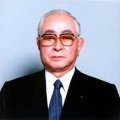 The terrorist attacks on the United States gave the whole world the maximum possible shock while bringing in the crisis of a severe economic slump. Here in Japan, we have entered a new phase of national diplomacy and security and the economic climate is in a quandary that offers no respite. Newspapers have an increasingly important role to play in this situation. The terrorist attacks on the United States gave the whole world the maximum possible shock while bringing in the crisis of a severe economic slump. Here in Japan, we have entered a new phase of national diplomacy and security and the economic climate is in a quandary that offers no respite. Newspapers have an increasingly important role to play in this situation.
For several years, there has been growing public criticism of aggressive newsgathering activities and media infringements of human rights -- such as the right of privacy -- in the course of newsreporting. Prompted by those criticisms, there has also been growing momentum for moves to tighten regulations on newsgathering and newsreporting activities. That momentum is evident in the submission to the National Diet of a bill to protect personal information from abuse for commercial purposes, in calls for the creation of a body to respond to human-rights violations by the media, and in proposed legislation to protect the social well-being of youth, among other initiatives.
In response to these developments, newspapers have voluntarily taken steps such as the adoption of a set of rules called the Canon of Journalism and the creation of a third-party committee to monitor newsreporting and to provide a forum for handling grievances. Toward the end of 2001, NSK's Editorial Affairs Committee formulated a policy guideline and a set of protections against the problems of the so-called media scrum, or aggressive newsgathering activities by media organizations. The committee took those steps in the belief that such problems should be resolved voluntarily by media organizations. A sub-committee is also working on a complete policy review on the operations of press clubs.
I would like to take this opportunity to here, again, reaffirm the newspaper industry's fundamental position of solidly opposing any attempt to impose undue regulations on newsgathering and newsreporting activities.
The comprehensive newspaper publicity promotion drive -- the so-called "Read Me" Campaign - aimed at increasing support among the general public and subscribers from all walks of life for the raison d'etre and activities of the newspaper industry, is now entering its third year. NSK's Circulation and Advertising committees are poised to take part in and cooperate with this drive. The full promotion of this campaign remains a pressing task for the newspaper industry.
The wave of the "age of reform" declared by Prime Minister Junichiro Koizumi is bearing down on newspaper companies. The newspaper industry faces a mountain of tasks that must be fully addressed. Those tasks include conducting a wholesale review of the operations and management of newspaper businesses, preserving and nurturing human resources -- including journalists, publishing newspapers that win the trust and support of readers, and responding to the dramatically changing media environment.
In accordance with the newly adopted Canon of Journalism and the Newspapers Sales Code, we are redoubling our efforts to live up to the expectations of the general public and subscribers and to maintain the place of newspapers as the central core of newsreporting media in the 21st century.
|
Aggregate Newspaper Circulation in Japan Stands at 53.68 million
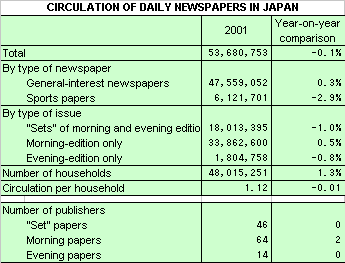 The NSK survey, "Circulation and Diffusion of Newspapers," has found that the aggregate newspaper circulation in Japan was 53,680,753 (copies) as of October 2001. That is down 0.1 percent from a year earlier. The NSK survey, "Circulation and Diffusion of Newspapers," has found that the aggregate newspaper circulation in Japan was 53,680,753 (copies) as of October 2001. That is down 0.1 percent from a year earlier.
NSK conducts a circulation survey every October.
By type of newspaper, the combined circulation of sports newspapers declined by a large 2.9 percent year-on-year (or 185,461) to 6,121,701. On the other hand, general-interest newspapers edged up by 0.3 percent (or 157,383) to 47,559,052.
One characteristic of 2001 that was revealed in the latest survey was that the circulation of general-interest newspapers increased. That is a turnaround from the year-on-year decline registered in the previous year. The increase was attributed to the tension-ridden international situation following the terrorist attacks on the United States.
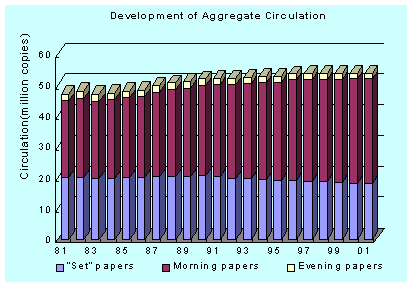 The survey also found that the decrease in the circulation of "set" newspapers, that is, "sets" of morning and evening editions, and the increased circulation of only morning editions are both continuing. The latest survey covered 124 newspapers, up by two newspapers from the year before. The survey also found that the decrease in the circulation of "set" newspapers, that is, "sets" of morning and evening editions, and the increased circulation of only morning editions are both continuing. The latest survey covered 124 newspapers, up by two newspapers from the year before.
With aggregate circulation down in the year-on-year comparison, the diffusion rate per household dipped slightly by 0.01 to 1.12 copies. If "sets" of morning and evening editions are counted as two copies, the aggregate circulation amounted to 71,694,148 copies, or a decrease of 202,181 copies from the year before. Using this calculation method, the newspaper diffusion rate per 1,000 people would be 567 copies, down three copies from the preceding year.
NSK Issues Guidelines on Self-Restraint for 'Media Scrums'
NSK's Editorial Affairs Committee on Dec. 6 issued a statement on collective aggressive newsgathering activities, or the so-called "media scrum." The statement included a guideline, or code of conduct, to be observed by news reporters and photographers. The Editorial Affairs Committee is made up of the managing editors and news editors of 58 NSK member newspapers and news agencies.
"Media scrum" is a term used to describe the actions of media people swarming around the involved parties or other persons concerned with major accidents or incidents in the aim of obtaining comments or information. Such actions can hamper the normal social life or infringe upon the privacy of the persons concerned and have drawn public criticism.
In its statement, NSK says that voluntary efforts on the part of media organizations to rectify this problem would help preserve the freedom of speech and uphold the people's right to know. The NSK statement says it will call on broadcasters and magazine publishers to act in concert with newspapers on the issue.
The statement cites a set of rules that should be respected by all media people. They include:
1) Not forcibly boxing-in reluctant persons to try to get their comments;
2) Respecting the feelings of bereaved kin and relatives in covering wakes, funeral services or the movement of remains; and
3) Trying to keep quiet while engaging in newsgathering activities in residential areas, schools, hospitals and other places.
The National Association of Commercial Broadcasters in Japan on Dec. 20 came out with a set of measures to protect against problems resulting from aggressive newsgathering activities and to rectify the problems of so-called media scrums, pledging to act in concert with NSK on the issue.
Itinerary Announced for Japan-U.S. Journalists' Exchange Program
An outline has been drafted of the itinerary for the Japan-U.S. journalists' exchange program for fiscal 2001, which was delayed until this year due to the terrorist attacks on the United States.
The exchange program is a collaborative effort between NSK and the International Center for Journalists, an organization for training journalists that is based in Washington, D.C.
According to the outline, a group of Japanese journalists and a group of U.S. journalists will visit the United States and Japan, respectively, for 17 days, starting on Feb. 13. The Japanese journalists will visit Washington, D.C., New York, Atlanta, Seattle and other places in the U.S. Included on the itinerary are a visit to The Washington Post to talk with the deputy foreign news editor about newsgathering related to terrorism and a courtesy call on the United Nations and CNN, among other events.
The U.S. journalists are to meet some leading Japanese politicians and business leaders, as well as visiting the Foreign Ministry and NTT DoCoMo. In the latter half of their itinerary, they will fly to Okinawa to visit U.S. military facilities and a local newspaper. On Feb. 27, the Japanese and U.S. participants will meet at the East-West Center in Hawaii to conclude their exchanges with joint discussions.
Topics.......Topics.......Topics........
|
Shinano-Mainichi's 40-Page Full-Color-Printing Facility in Full Operation
The Shinano-Mainichi Shimbun, the publisher of a daily newspaper with a circulation of 470,000 copies in Nagano Prefecture, on Dec. 10 put its new newspaper-printing facility, the Nagano Production Center, into full operation.
The facility is capable of 40-page full-color printing -- the first newspaper facility of its kind. The factory features computer-to-plate (CTP) equipment that dramatically simplifies the plate-making process. The new facility replaces the company's head-office printing facility, which has been shut down.
The new factory prints 280,000 copies of the morning edition and 36,000 copies of the evening edition. It has a total floor space of 7,500 square meters housing two sets of five shaftless press machines manufactured by Tokyo Kikai that can print up to 40 full-color pages. The system allows the use of color on every page. Shinano-Mainichi is the third Japanese newspaper company to introduce the CTP system that creates plates for the presses directly from computer screens, skipping the process of filmmaking. Nikkei and the Kochi Shimbun already have such systems.
Shinano-Mainichi has also replaced the vinyl and polypropylene bands used to pack and bundle printed newspaper copies for delivery with environment-friendly paper-based bands in a first for Japan's newspaper industry. Tokyo Kikai also makes the new paper-bundling equipment.
Press Photographers Association Announces 2001 Awards
The local branches of the Press Photographers Association have been announcing their recipients of the annual association awards for 2002.
The society comprises newspapers and broadcasters and has active branches in the Tokyo, Kansai (Osaka), Hokkaido, Tohoku and Kyushu areas. There is also an active Kansai Society of Photo Editors at Sports Papers.
The following is the list of recipients of awards announced by the Tokyo and Hokkaido branches of the News Photographers' Society and the Kansai Society of Photo Editors at Sports Papers.
The Tokyo Press Photographers Associarion Award
Recipient: Koji Harada (Kyodo News) |
 |
|
"Fall of Kabul": a series of photographs by Harada, who rushed to the capital of Afghanistan upon its seizure by the Northern Alliance, ahead of other news photographers from foreign news agencies
|
|
|
The Hokkaido Press Photographers Associarion Award
Recipient: Toshikazu Sato (Hokkaido branch of The Yomiuri Shimbun)
|
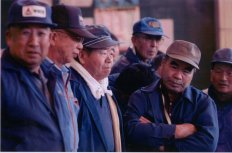 |
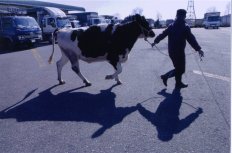 |
|
"At the Cattle Market in Tokachi, the Largest Livestock Production Center in Hokkaido": the photo shows grim-faced local livestock market officials and a farmer who is taking home a cow that did not get a bid at the market, despite the government's declaration of the safety of the nation's beef cattle after the discovery of Japan's first case of an animal infected with mad-cow disease
|
|
|
The Kansai Society of Photo Editors at Sports Papers Award
Recipient: Motohiro Araki (Osaka branch of Kyodo News)
|
 |
|
"Shinjo Leaping to Catch a Ball": the photo catches the moment as Japanese baseball player Tsuyoshi Shinjo jumps high to catch a hit at a game between the New York Mets and the Montreal Expos in Montreal, Canada
|
|
Story of this month>>>>
Damages Awarded in Media-Related Litigations Soar in 2001
|
|
Court-ordered damages assessed against media companies for libel and other complaints well exceeded 5 million yen in some cases in 2001, drawing considerable public notice.
In the past, such damages had generally been less than 1 million yen, rising to about 3 million yen only in some particular cases. But in one court ruling in 2001, the mass-circulation weekly magazine "Shukan Post", published by the major publishing house Shogakkan, was ordered to pay 10 million yen to slugger Kazuhiro Kiyohara of the Yomiuri Giants.
Against a backdrop of surging public distrust of media organizations and growing awareness of the importance of protecting human rights, there has been some favorable response to the rise in the size of such court-ordered awards. On the other hand, especially in the case of a court ruling that awarded high damages to a politician, there has also been criticism that such awards might lead the government to impose tight regulations on newsreporting.
The general level of compensation in libel cases had ranged from under 1 million yen to up to 3 million yen from around 1965 until last year. Although some argued that the size of damage awards in Japanese libel cases was too low compared to that in the U.S. and Europe, others warned against a straight comparison. In the U.S., for instance, freedom of expression is much more broadly guaranteed than in Japan. It is an established judicial theory in the U.S. that in the case of libel suits filed by public figures such as politicians; the complainant has to prove the actual malice on the part of the offending media organization.
In Japan, courts tend to grant higher damages to big-name figures and public figures with the view that the value of their honor is higher than that of common people and the extent of the damage is accordingly larger. But that judicial presumption is now seen by many people to be unwarranted.
Weekly magazines have been named as defendants in many media-related libel cases. A 1997 Supreme Court decision prohibited the ordering of damage awards in civil libel suits in order to prevent the common recurrence of such cases, opting instead for recourse to punitive measures or sanctions.
There has been growing public criticism of the media for a spate of incidents in which newsreporting activities allegedly defamed or infringed upon the human rights of individuals. People whose human rights have been violated or whose honor has been besmirched by newsreporting have been held up as an excuse by the government and the ruling parties for a drive to tighten regulations on the activities of the media.
As a result, the increasing size of court-ordered damage awards in libel suits against weekly magazines might end up as serving as further justification for the condemnation of the media as a whole, newspapers included. The recent courtroom developments are therefore causing considerable concern within the newspaper industry.
|
|
|
Nihon Shinbun Kyokai
The Japan Newspaper Publishers & Editors Association
Nippon Press Center Bldg., 2-2-1 Uchisaiwai-cho, Chiyoda-ku,
Tokyo100-8543, Japan
bulletin@pressnet.or.jp.
Copyright 2002 Nihon Shinbun Kyokai
All right reserved
|
|
|
|
 The terrorist attacks on the United States gave the whole world the maximum possible shock while bringing in the crisis of a severe economic slump. Here in Japan, we have entered a new phase of national diplomacy and security and the economic climate is in a quandary that offers no respite. Newspapers have an increasingly important role to play in this situation.
The terrorist attacks on the United States gave the whole world the maximum possible shock while bringing in the crisis of a severe economic slump. Here in Japan, we have entered a new phase of national diplomacy and security and the economic climate is in a quandary that offers no respite. Newspapers have an increasingly important role to play in this situation. The NSK survey, "Circulation and Diffusion of Newspapers," has found that the aggregate newspaper circulation in Japan was 53,680,753 (copies) as of October 2001. That is down 0.1 percent from a year earlier.
The NSK survey, "Circulation and Diffusion of Newspapers," has found that the aggregate newspaper circulation in Japan was 53,680,753 (copies) as of October 2001. That is down 0.1 percent from a year earlier. The survey also found that the decrease in the circulation of "set" newspapers, that is, "sets" of morning and evening editions, and the increased circulation of only morning editions are both continuing. The latest survey covered 124 newspapers, up by two newspapers from the year before.
The survey also found that the decrease in the circulation of "set" newspapers, that is, "sets" of morning and evening editions, and the increased circulation of only morning editions are both continuing. The latest survey covered 124 newspapers, up by two newspapers from the year before.


